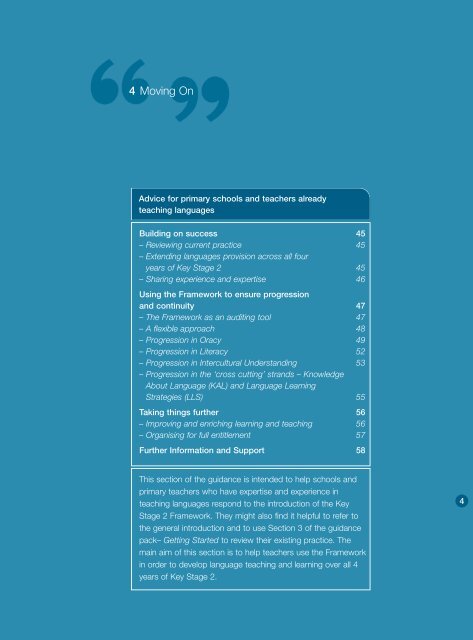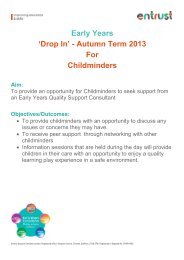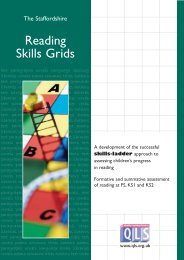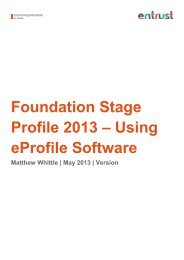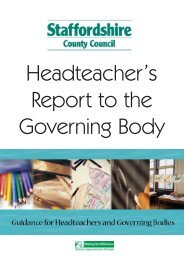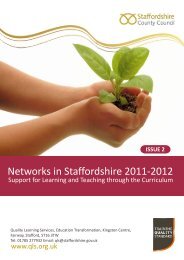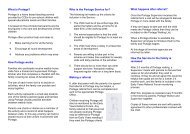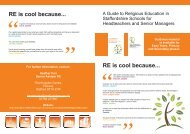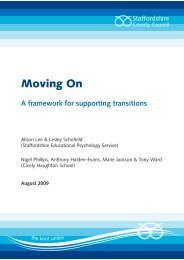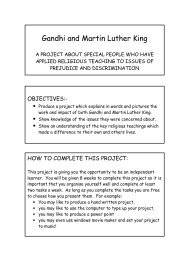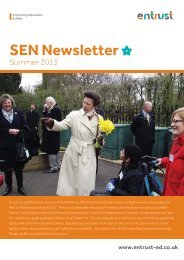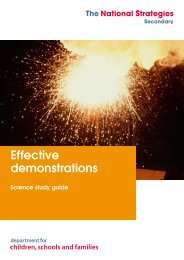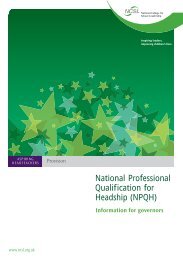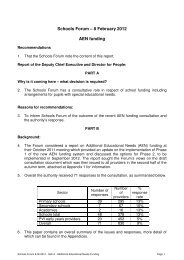KS2 Framework for Languages: Guidance - Staffordshire Learning Net
KS2 Framework for Languages: Guidance - Staffordshire Learning Net
KS2 Framework for Languages: Guidance - Staffordshire Learning Net
You also want an ePaper? Increase the reach of your titles
YUMPU automatically turns print PDFs into web optimized ePapers that Google loves.
4 Moving On<br />
Advice <strong>for</strong> primary schools and teachers already<br />
teaching languages<br />
Building on success 45<br />
– Reviewing current practice 45<br />
– Extending languages provision across all four<br />
years of Key Stage 2 45<br />
– Sharing experience and expertise 46<br />
Using the <strong>Framework</strong> to ensure progression<br />
and continuity 47<br />
– The <strong>Framework</strong> as an auditing tool 47<br />
– A flexible approach 48<br />
– Progression in Oracy 49<br />
– Progression in Literacy 52<br />
– Progression in Intercultural Understanding 53<br />
– Progression in the ‘cross cutting’ strands – Knowledge<br />
About Language (KAL) and Language <strong>Learning</strong><br />
Strategies (LLS) 55<br />
Taking things further 56<br />
– Improving and enriching learning and teaching 56<br />
– Organising <strong>for</strong> full entitlement 57<br />
Further In<strong>for</strong>mation and Support 58<br />
This section of the guidance is intended to help schools and<br />
primary teachers who have expertise and experience in<br />
teaching languages respond to the introduction of the Key<br />
Stage 2 <strong>Framework</strong>. They might also find it helpful to refer to<br />
the general introduction and to use Section 3 of the guidance<br />
pack– Getting Started to review their existing practice. The<br />
main aim of this section is to help teachers use the <strong>Framework</strong><br />
in order to develop language teaching and learning over all 4<br />
years of Key Stage 2.<br />
4
Building on success<br />
Reviewing current practice<br />
Some schools have a long tradition of providing opportunities to learn a new language.<br />
Even more have made an excellent beginning in recent years. For such schools and their<br />
teachers many of the <strong>Framework</strong>’s learning objectives and suggested activities will not be new.<br />
For example most children will already be listening and responding to simple songs (O3.1) or<br />
acting out simple role plays (activity <strong>for</strong> O3.3).<br />
The principles underlying the <strong>Framework</strong> will also be familiar. They reflect principles of learning<br />
and teaching as those described in Excellence and Enjoyment: building on success, making<br />
learning real and enjoyable, providing a rich learning experience across the curriculum and<br />
involving children as partners.<br />
There are also aspects to the <strong>Framework</strong> which may be less familiar and challenging.<br />
There is a strong emphasis on oracy – and in particular ‘education of the ear’ which may be<br />
less common in other parts of the primary curriculum; in some schools children may not yet<br />
have had much exposure to the written word in the new languages; in others the intercultural<br />
aspect may be less developed. Very few teachers will yet have had the opportunity to see<br />
children progress through 4 years of language learning.<br />
The <strong>Framework</strong> provides a key resource <strong>for</strong> teachers to review their current practice and<br />
experience, to see where there are possible gaps and to decide how best to develop<br />
language learning and teaching in the future.<br />
Extending provision across the four years of Key Stage 2<br />
There is much exciting language learning taking place in primary schools already.<br />
The enthusiasm of the children is very real and many are making noticeable learning gains.<br />
The challenge now is to build on that good practice and enthusiasm in order to sustain a<br />
meaningful experience of language learning over 4 years. The Key Stage 2 <strong>Framework</strong> <strong>for</strong><br />
languages provides a comprehensive set of objectives and recommended activities to help<br />
that process over time.<br />
Skilled and experienced primary teachers with competence in language(s) will be critical to<br />
this development both in supporting the extension of languages provision to all children in<br />
Key Stage 2 and in the dissemination and extension of good practice within their schools<br />
and beyond.<br />
four<br />
The Key Stage 2 <strong>Framework</strong> <strong>for</strong> <strong>Languages</strong> – Moving On<br />
45
46<br />
Sharing experience and expertise<br />
There is also considerable diversity in current languages provision across the country.<br />
The <strong>Framework</strong> will support greater coherence and provide support <strong>for</strong> collaborating and<br />
developing programmes within and between schools and across Local Authorities. Because it<br />
is flexible and can be introduced gradually over the next 4 years, the <strong>Framework</strong> can be used<br />
in a full range of different contexts and circumstances. It assumes that primary teachers will be<br />
central to decisions relating to what and how to teach a language or languages to their pupils.<br />
As the <strong>Framework</strong> is assimilated into whole school plans, teachers with existing expertise<br />
and experience in language(s) will have an important role in working with colleagues who<br />
are introducing languages <strong>for</strong> the first time. They may become mentors to trainees or Newly<br />
Qualified Teachers (NQTs) with language skills; they may wish to model lessons <strong>for</strong> other<br />
colleagues, or in some cases take on the role of Subject Coordinator. Many teachers will be<br />
working with assistants who have language skills or with secondary colleagues supporting<br />
primary languages learning.<br />
The Key Stage 2 <strong>Framework</strong> <strong>for</strong> <strong>Languages</strong> is intended to provide a common frame of<br />
reference to support this collaborative and developmental work.
Using the <strong>Framework</strong> to ensure progression and continuity<br />
The <strong>Framework</strong> is designed to underpin the ambition set out in the National <strong>Languages</strong><br />
Strategy that:<br />
“Every child should have the opportunity throughout Key Stage 2 to study a <strong>for</strong>eign<br />
language and develop their interest in the culture of other nations”<br />
The expectation is that most children will be able to reach a level of competence in a language<br />
(or in some cases languages), as defined by the Common European <strong>Framework</strong> (CEF) or<br />
The <strong>Languages</strong> Ladder. More detailed in<strong>for</strong>mation about the Ladder and the CEF will be<br />
contained in the Part 3 of the <strong>Framework</strong> documentation – Planning <strong>for</strong> Entitlement. In broad<br />
terms, however, this means that after four years of language learning most Year 6 children will<br />
be able to understand simple spoken and written language, to speak aloud and take part in<br />
short conversations, and to write simple sentences. They will also understand about different<br />
cultures and have an idea about how languages work and how to learn them. In short they will<br />
be becoming confident users and learners of a new language.<br />
The <strong>Framework</strong> as an auditing tool<br />
The expectations and outcomes <strong>for</strong> Year 6 children are set out in more detail in the <strong>Framework</strong><br />
itself. Teachers might wish to consider these as longer term ambitions and to compare them to<br />
their current practice and the opportunities currently offered to children.<br />
They might <strong>for</strong> example compare the ‘Outcomes’ <strong>for</strong> Oracy Year 3:<br />
• Enjoy listening to and speaking in the language<br />
• Listen and respond to familiar spoken words, phrases and sentences<br />
• Communicate with others using simple words and phrases and short sentences<br />
• Understand conventions such as taking turns to speak, valuing the contribution of others<br />
• Use correct pronunciation in spoken work.<br />
With the suggested outcomes <strong>for</strong> Year 6:<br />
• Listen to and understand the main points and some detail from a short spoken passage<br />
• Give a presentation in a clear audible voice<br />
• Converse briefly without prompt<br />
• Enjoy listening and speaking confidently.<br />
How does existing practice relate to these outcomes? What might be done to help<br />
develop learners further? The sample activities will be of help here since they illustrate in<br />
a practical manner what it is that teachers and pupils are invited and encouraged to do<br />
to achieve the objectives.<br />
four<br />
The Key Stage 2 <strong>Framework</strong> <strong>for</strong> <strong>Languages</strong> – Moving On<br />
47
48<br />
Experienced teachers will be aware that these strands are interdependent as this example from<br />
Year 5 demonstrates. In the following example Oracy supports Literacy and is in turn rein<strong>for</strong>ced<br />
by it. The cross cutting strand Knowledge about Language helps learners to internalise and<br />
create new language.<br />
Spotlight: Progression through storytelling<br />
Children in Year 5 listen to a German version of the story of the Very Hungry Caterpillar<br />
modelled by their teacher using the Interactive Whiteboard. Using their existing knowledge<br />
of the story and of key words and structures, children begin to reconstruct the story.<br />
Using a through the keyhole technique parts of the sentences are revealed slowly and<br />
children suggest words and phrases to complete the text. They chant the familiar refrain<br />
‘aber satt war sie noch immer nicht’. They build up the story adding more and more food<br />
items and making more complex sentences. In groups children prepare their own versions<br />
of the story and present them using PowerPoint.<br />
O5.3 Listen attentively and understand more complex phrases and sentences.<br />
L5.1 Re-read frequently a variety of short texts.<br />
L5.2 Make simple sentences and short texts.<br />
O5.4 Prepare a short presentation on a familiar topic.<br />
KALO5.4 Apply knowledge of language rules and conventions when buildings<br />
hort sentences.<br />
A flexible approach<br />
The <strong>Framework</strong> is not a cage. It is designed to empower teachers and to support the<br />
freedoms set out in Excellence and Enjoyment. It sets out a clear progression path across<br />
the four years of Key Stage 2, describing a clear model of progression through increasing<br />
complexity of skill (language competence) and understanding (about language, culture and<br />
learning). How these objectives are met is a matter <strong>for</strong> individual schools and teachers to<br />
discuss and decide.<br />
Teachers and schools will have the freedom to decide:<br />
• How to teach<br />
• What to teach<br />
• How to organise the teaching.<br />
The general introduction to the <strong>Framework</strong> guidance documentation suggests some<br />
general approaches to language learning and teaching (guidance section 1 – Primary<br />
Language <strong>Learning</strong>), but it will be <strong>for</strong> teachers to decide what is appropriate <strong>for</strong> their children.<br />
National and local Continuing Professional Development courses on primary language teaching<br />
will also support teachers in making those choices.
The <strong>Framework</strong> does not prescribe language or content, so schools are free to decide<br />
<strong>for</strong> themselves the languages, themes and content they wish to teach. Such decisions will<br />
often be taken in consultation with the Local Authority and local secondary schools.<br />
The <strong>Framework</strong> does not assume any one way of organising the teaching and learning of<br />
languages. It allows <strong>for</strong> a range of organisational models, which the <strong>Framework</strong> supports,<br />
<strong>for</strong> example:<br />
• Some schools may wish to offer a single language taught across four years, often<br />
in collaboration with a local secondary school<br />
• Some schools wish to offer experience of a range of different languages, developing<br />
knowledge about language and language learning strategies, in the early stages and<br />
concentrating on a single language later in the learning process<br />
• Some schools have adopted a two language model.<br />
Progression in Oracy<br />
Oracy, defined as listening, speaking and spoken interaction, has a more prominent place in<br />
language learning than in other areas of the curriculum. It is in a real sense both the medium<br />
and the message. All learners acquire language through exposure to that language, enabling<br />
them to assimilate and re-use it. For young learners in particular oracy is fundamental to their<br />
learning. From an early age children should be given regular and frequent opportunities to listen<br />
to the new language – ‘educating the ear’ – so that they are able to identify and distinguish<br />
new sounds, to reproduce and re-use them and to make links between the sounds and written<br />
<strong>for</strong>m of the language.<br />
Spotlight: Using authentic popular songs<br />
To help children recognise new sounds in the language, children in Year 3 listen to popular<br />
songs on CD, such as those of Henri Dès. Every time they hear a particular sound or word,<br />
<strong>for</strong> example, ‘soleil’ they use physical response, drawing a circular sun in the air to show<br />
that they have recognised the word. Another challenge <strong>for</strong> the children can be to keep<br />
count of how many times they hear a particular sound or word, checking their scores in<br />
French with one another when the song is finished.<br />
O3.2 Recognise and respond to sound patterns and words<br />
four<br />
The Key Stage 2 <strong>Framework</strong> <strong>for</strong> <strong>Languages</strong> – Moving On<br />
49
50<br />
In Year 3 the <strong>Framework</strong> objectives <strong>for</strong> Oracy include:<br />
• O3.1 Listen and respond to simple rhymes, stories and songs<br />
• O3.2 Recognise and respond to sound patterns and words<br />
• O3.4 Listen attentively and understand instructions, everyday classroom language<br />
and praise words.<br />
These objectives are supported by a range of possible teaching activities, many of which do<br />
not require a verbal response:<br />
• Copy actions modelled by the teacher or respond with a physical action<br />
• Clap each time they hear a word that rhymes.<br />
In this way children are hearing and responding to the sounds of the new language.<br />
This emphasis on maximum exposure to the sound patterns of the new language is of vital<br />
importance because, unlike with their mother tongue, children will be reliant on the school<br />
and classroom environment to provide much of their spoken language experience.<br />
Resources to support oracy<br />
As well as the class teacher, there are many other resources to support this vital education<br />
of the ear. Children can have experience of a variety of native speaker voices in the new<br />
language through the use of video, DVD, audio texts and the internet. Access to live native<br />
speakers is also enormously valuable. This might include local community contacts, the<br />
provision of a Foreign Language Assistant (FLA) through the scheme organised by the<br />
British Council or contact with expert speakers from secondary schools including Specialist<br />
Language Colleges.<br />
Increasingly schools are also finding ways to establish links with schools in the country of<br />
the new language – both virtual and real. Local Authorities may have existing links; the<br />
British Council’s Global Gateway is also a source of support <strong>for</strong> establishing new links.<br />
Over four years children will develop from listening and understanding and simple<br />
communicative tasks to more complex spoken interaction, re-using familiar words in new<br />
contexts. By Year 6 they will be able to participate in more extended conversations and<br />
express some opinions and ideas.
Spotlight: Celebrating success<br />
Class 6 pupils are invited to present short dialogues to the school in Praise Assembly.<br />
Children work in pairs analysing what they need to know to be able to prepare their<br />
conversations. They work independently and re-use as much of their prior learning as they<br />
can. They produce and display their dialogues in the communal areas <strong>for</strong> younger pupils to<br />
read. In assembly a number of pupils per<strong>for</strong>m their dialogues from memory, using the<br />
language as naturally as possible.<br />
O6.2 Per<strong>for</strong>m to an audience<br />
O6.4 Use language confidently to initiate and sustain conversations.<br />
Teachers can plan <strong>for</strong> such progression using the <strong>Framework</strong> objectives and suggested<br />
activities over a number of years.<br />
Objective<br />
O3.3 Per<strong>for</strong>m simple communicative<br />
tasks using single words phrases<br />
and short sentences.<br />
O4.4 Ask and answer questions on<br />
several topics.<br />
O5.1 Prepare and practise a simple<br />
conversation, re-using familiar voicabular<br />
and structures in<br />
new contexts.<br />
O6.4 Use spoken language confidently to<br />
initiate and sustain conversations<br />
and to tell stories.<br />
Teaching activity<br />
Ask and answer simple questions using real<br />
objects, cards and games.<br />
Develop role play using puppets or props.<br />
Use imagination to create interesting<br />
conversations using familiar language.<br />
Sustain a conversation within the class or<br />
with visitors.<br />
four<br />
The Key Stage 2 <strong>Framework</strong> <strong>for</strong> <strong>Languages</strong> – Moving On<br />
51
52<br />
Progress in Oracy is supported by and developed through the learning objectives of the<br />
other four strands. Children benefit from knowing how the sounds they hear and use are<br />
represented in the written <strong>for</strong>m. Children’s personal development is enriched by understanding<br />
how language reflects culture and underpins different social conventions and behaviours.<br />
Progress is more rapid where children have opportunities to develop greater insight into<br />
how languages work and how they are learnt. In this way, it can be seen that the five<br />
strands are interdependent.<br />
Progression in Literacy<br />
Literacy – access to and use of written language – is supported by and in turn rein<strong>for</strong>ces the<br />
development of oracy. The introduction of children to reading and writing in the new language<br />
has been a controversial issue in the past. Some teachers have felt instinctively, based perhaps<br />
on their own experiences as learners, that this could be too demanding <strong>for</strong> young learners.<br />
However, the careful introduction of literacy skills as part of a rich learning environment,<br />
stimulating communication and understanding in speech and writing can only be beneficial.<br />
From an early age children become familiar with the relationship between sounds and<br />
letters/characters in the new language and apply this in their reading and spelling. There is of<br />
course no expectation that children’s levels of literacy in a new language will immediately<br />
equate with their levels of literacy in English or another first language. However, the Key Stage<br />
2 <strong>Framework</strong> <strong>for</strong> <strong>Languages</strong> is specifically linked to the National Literacy Strategy, and the<br />
learning of the new language will be helped by children’s previous understanding of their own<br />
language, and will in turn develop their general literacy skills. It is useful there<strong>for</strong>e <strong>for</strong> all<br />
teachers of primary languages to be familiar with the ways in which Key Stage 1 pupils have<br />
been taught literacy in order to be able to use some of these same concepts (in <strong>for</strong> example<br />
the area of phonics) in their teaching of the new language.<br />
This is especially important in relation to the development of writing skills, where the<br />
<strong>Framework</strong> outlines a careful development from supported to independent writing, related<br />
at every stage to other language learning skills. This planned progression in writing can be<br />
summarised as follows:<br />
Y3 write familiar words using a model; write some familiar words from memory.<br />
Y4 write simple words and phrases from a model and some from memory.<br />
Y5 write short texts with support.<br />
Y6 write sentences from memory and develop short texts using a model.
As the example of emergent writing through play quoted in guidance section 3, suggests,<br />
many children seek opportunities to write, regarding writing as no less ‘fun’ than singing or<br />
role-play. The <strong>Framework</strong> will help teachers to guide pupils as they develop their written<br />
language skills over four years or more.<br />
Children’s ability to read in their first language(s) will also have a significant bearing on their<br />
progress in a new language, although the levels of per<strong>for</strong>mance will inevitably be different.<br />
Children will develop from ‘recognising some familiar words’ in Year 3 to ‘identifying different<br />
text types and reading short, authentic texts <strong>for</strong> enjoyment or in<strong>for</strong>mation (such as an email<br />
message)’ in Year 6 <strong>for</strong> example. Pupils should be encouraged to exploit to the full all the<br />
reading skills they have acquired in both Key Stage 1 and Key Stage 2 in trying to make<br />
sense of new language words, sentences and texts.<br />
Spotlight: Cross curricular work on evacuees<br />
This project brought together work in English, Drama, History and languages. The children<br />
read and studied a novel, about wartime evacuation. They gained first hand experience of<br />
evacuation through dramatic re-enactment, handling historical artefacts, and interviewing<br />
older people in their community. Through such direct personal and kinaesthetic experience,<br />
through writing in role and learning in a meaningful context they developed understanding<br />
of, and empathy with, the situation of evacuees. Combining these insights with reading<br />
skills acquired through literacy teaching in both Key Stage 1 and Key Stage 2 they were<br />
able to make sense of short texts in a new language, in this case French.<br />
They were, <strong>for</strong> instance, able to interpret a postcard written in French from a child<br />
being evacuated. They recognised common letter strings, they detected pattern, they<br />
knew some key words, they draw analogies, they used the pictures to provide contextual<br />
background. They interpreted meaning from both context and prior knowledge of language<br />
(<strong>for</strong> example cognates).<br />
L6.1 Read and Understand the main points and some detail from a short written passage.<br />
L6.2 Identify different text types and read short, authentic texts <strong>for</strong> enjoyment or in<strong>for</strong>mation.<br />
Progression in Intercultural Understanding<br />
A language and its culture are inextricably linked. Primary aged children are open to new<br />
experiences and fascinated to encounter the world in different ways. Language learning<br />
presents a unique opportunity <strong>for</strong> such appreciation of difference – through traditional songs,<br />
stories and rhymes, through contact with native speakers and through the language itself.<br />
four<br />
The Key Stage 2 <strong>Framework</strong> <strong>for</strong> <strong>Languages</strong> – Moving On<br />
53
54<br />
Even the simplest elements of language have a cultural dimension. In many languages<br />
(except <strong>for</strong> English) there are ‘polite’ and ‘familiar’ expressions <strong>for</strong> ‘you’ and this gives<br />
messages about how people behave in different cultures. Basic rules of social interaction –<br />
shaking hands, bowing, <strong>for</strong>ms of address all represent a particular way of interrelating with<br />
people. Even the order of words in a sentence may have a cultural significance. Children who<br />
speak more than one language may be able to share their experiences with their peers.<br />
By learning a new language children should be encouraged to take an interest in the lives of<br />
others and to look at things from the perspective of others, including in many cases children<br />
from other cultures in their own school. They should develop a sensitivity to the similarities<br />
and differences between peoples, their daily lives, their beliefs and values. Teachers should<br />
endeavour to present a different culture, with its norms and expectations, as they introduce<br />
the new language. This can be rein<strong>for</strong>ced by direct contact with the culture through access to<br />
native speakers, ‘special’ language days, educational visits abroad, links with schools in other<br />
countries, or using the internet, email or videoconferencing.<br />
At the beginning of Key Stage 2 pupils encounter the fact of linguistic diversity and reflect on<br />
the range of different languages and cultures. They focus on cultural specifics such as different<br />
festivals, celebrations and special days, Spanish fiestas, Bastille day, Diwali (IU4.1 ‘learn about<br />
festivals and celebrations in different cultures’), or typical names in different cultures (IU3.3<br />
‘identify social conventions at home and in other cultures’). In Years 5 and 6 they approach<br />
more demanding issues like attitudes and prejudice (IU6.1 ‘compare attitudes towards aspects<br />
of everyday life’).<br />
Much of the Intercultural Understanding strand can provide content <strong>for</strong> language learning,<br />
in particular all of those elements involving celebration and per<strong>for</strong>mance or contact with the<br />
culture and people of the new language.<br />
Spotlight: Predicting the plot of a traditional story<br />
The traditional Spanish story, El ratoncito Pérez, provides an opportunity <strong>for</strong> children to<br />
compare characteristics of simple stories between cultures. They use the picture cues and<br />
their experience of hearing traditional stories in their first language to predict what the plot<br />
of the story is about. They find the symbols that are used <strong>for</strong> punctuation, exploring<br />
whether they help to understand the meaning of the text.<br />
IU4.3 Compare traditional stories; KAL Identify narrative <strong>for</strong>ms in a different language and<br />
compare to those in English; LLS Make sensible predictions based on previous knowledge<br />
and language cues.
Other aspects of intercultural understanding can also be taught within the broader curriculum,<br />
<strong>for</strong> example discussing what it feels like to be a child arriving in an English school who does<br />
not speak any English (IU5.1 ‘look at further aspects of their everyday lives from the<br />
perspective of someone from another country’) or exploring the concept of stereotype<br />
(IU6.2 ‘recognise and understand some of the differences between people’).<br />
Such topics can be linked with work in other subject areas such as PSHE, Geography, English<br />
or History. In Part 3 of the <strong>Framework</strong> documentation – Planning <strong>for</strong> Entitlement and in the online<br />
version, a list of cross curricular links shows some of these correspondences in detail.<br />
Cultural institutes <strong>for</strong> the main Foreign Embassies are also a good source of in<strong>for</strong>mation,<br />
advice and materials to supplement language and learning in primary.<br />
Progression in the cross-cutting strands of Knowledge About Language (KAL)<br />
and Language <strong>Learning</strong> Strategies (LLS)<br />
The two cross-cutting strands are important tools <strong>for</strong> learning. They arise from and support<br />
the three core strands. When children learn a new language they reinterpret and consolidate<br />
the knowledge and understanding that they gained in learning their first language(s).<br />
They develop insights into the nature of language and its social and cultural significance.<br />
As they interact more in the new language they deepen their understanding of how language<br />
works. Teachers should encourage children to make explicit comparisons between the new<br />
language and English, and to analyse similarities and differences. Subtle aspects of the new<br />
language which learners appreciate intuitively, such as how pronunciation and intonation affect<br />
meaning, can be specifically drawn to children’s attention and discussed.<br />
In Year 3 pupils are at the stage of becoming aware of the variety of languages that exist and<br />
of recognising sound patterns, including making distinctions, <strong>for</strong> example between question<br />
<strong>for</strong>ms and statements, or between affirmatives and negatives. Through the years of Key Stage<br />
2 their awareness of language grows and by Year 6 they have acquired a more solid<br />
knowledge of language structures which underpins their abilities in Oracy and Literacy.<br />
The Language <strong>Learning</strong> Strategies strand works in a similar way. Young children learning a<br />
new language simultaneously become familiar with strategies that they can apply to the<br />
learning of any language. By selecting and using different strategies, children develop<br />
awareness of how they learn and refine the ability to plan to use specific strategies <strong>for</strong><br />
particular tasks. To maximise the potential benefits of this process the <strong>Framework</strong> helps<br />
teachers, to make this learning explicit. In the early years of Key Stage 2 they can discuss with<br />
children, <strong>for</strong> example, how rhymes help them to remember words and phrases, and how the<br />
context in which they encounter a word can help them to determine its meaning and<br />
subsequently to recall it. Later in Key Stage 2, children will extend their capabilities to include<br />
skills such as using a bilingual dictionary and memorising language. By Year 6 children should<br />
have developed a repertoire of techniques to support their understanding and use of the new<br />
language using key words, listening <strong>for</strong> cues, making predictions.<br />
four<br />
The Key Stage 2 <strong>Framework</strong> <strong>for</strong> <strong>Languages</strong> – Moving On<br />
55
56<br />
Taking things further<br />
The <strong>Framework</strong> provides a frame of reference <strong>for</strong> auditing current practice and developing<br />
appropriate progression paths <strong>for</strong> primary children, starting from where schools are now.<br />
It may also help schools and teachers to develop a more long term vision of languages in<br />
the primary curriculum.<br />
Improving and enriching learning and teaching<br />
Already many primary schools appreciate the value of making the new language part of the<br />
children’s whole experience at school by embedding it in daily routines and regular events<br />
and linking it to other learning.<br />
Spotlight: Encouraging children to use language <strong>for</strong> real from Key Stage 1<br />
In a mixed age class of Years1 and 2, the teacher sees the benefit of an early start to using<br />
language <strong>for</strong> real purposes. He introduces the words <strong>for</strong> classroom objects, using a range<br />
of techniques. The children enjoy repeating the words louder and softer, faster and slower.<br />
The teacher holds up an object but doesn’t always say the right word <strong>for</strong> it. The children<br />
repeat if it’s correct and remain silent if it is not correct.<br />
O3.3 LLS Recognise words that the teacher mouths silently<br />
The teacher sets the words in context by introducing simple verb structures such as<br />
“Pass me the pencil, please. Thank you”. The children practise the language around the<br />
class, in a simple conversation chain taking turns to pass a number of familiar objects along<br />
the line. The children try to use the new language as often as possible during the day, when<br />
working with others and requesting equipment.<br />
O3.3 Per<strong>for</strong>m simple communicative tasks using single words, phrases or short<br />
sentences; KAL Hear main word classes; recognise conventions of politeness and<br />
engage in turn taking<br />
Such embedding creates gains not only <strong>for</strong> the language learning but <strong>for</strong> the whole learning<br />
experience of the child. The expectation, there<strong>for</strong>e, is that language learning will increasingly<br />
become a normal part of the primary curriculum. This possibility of making the new language(s)<br />
part of children’s daily life is a major advantage of the primary school. Increasingly primary<br />
schools should do as much as possible to develop this integrated learning experience.<br />
In addition to embedding, the <strong>Framework</strong> suggests specific links which might be made<br />
between its <strong>Learning</strong> Objectives and objectives in a range of other subjects including English,<br />
Maths, Literacy, Numeracy, Music, History, Geography, PE, PSHE, and ICT. These links<br />
exemplify the inter-relationship of knowledge emphasised in Excellence and Enjoyment.<br />
Teachers should use such links to help children understand how their learning in one area<br />
of the curriculum can promote their progress in others.
Language learning also has a specific contribution to make to the primary curriculum.<br />
By recognising and celebrating existing cultural diversity by bringing other cultures into the<br />
classroom, it offers unique insights into language, literacy and the world in which children live,<br />
both now and in the future. In the words of one 8 year old learner<br />
“<strong>Learning</strong> a language is like having a window in my head, and through the window I can<br />
see other people”<br />
As teachers become more familiar with the <strong>Framework</strong> and schools develop greater expertise<br />
in languages, it is to be anticipated that a rich language learning environment will increasingly<br />
become the norm. Children will have real contacts with speakers of the new language – e.g.<br />
Foreign Language Assistants – as well as e-mail and video links to children in other countries.<br />
A wide range of resources, including ICT resources will also help make the language learning<br />
experience real and relevant to young learners throughout Key Stage 2. Because it is a<br />
reference tool <strong>for</strong> the future as well as <strong>for</strong> the present, the <strong>Framework</strong> will support these<br />
developments as well as some others that we may not yet have imagined.<br />
Organising <strong>for</strong> full entitlement<br />
To achieve this rich and exciting environment <strong>for</strong> learning and teaching, schools and teachers<br />
will need to plan over four years. Primary language learning will be underpinned by detailed<br />
organisation on key issues such as:<br />
• Long, medium and short term planning<br />
• Use of other adults in support of languages<br />
• Assessment and Assessment <strong>for</strong> <strong>Learning</strong><br />
• Continuity and Transfer to KS3.<br />
Some general advice on these and other related matters is contained in the general<br />
introduction to this guidance (‘Primary Language <strong>Learning</strong>’), and more detailed exemplification<br />
and case studies will be a major feature of Part 3 of the <strong>Framework</strong> documentation – Planning<br />
<strong>for</strong> Entitlement.<br />
four<br />
The Key Stage 2 <strong>Framework</strong> <strong>for</strong> <strong>Languages</strong> – Moving On<br />
57
58<br />
Further In<strong>for</strong>mation and Support<br />
The best starting point <strong>for</strong> more detailed advice, both on the <strong>Framework</strong> itself and about other<br />
sources of support, is to be found on the National Advisory Centre <strong>for</strong> Early Language <strong>Learning</strong><br />
(NACELL) website, www.nacell.org.uk.<br />
Other sources of in<strong>for</strong>mation include:<br />
The National Curriculum online website has details of the non-statutory guidelines <strong>for</strong> primary<br />
language learning www.nc.uk.net/nc_resources/html/MFL_k2.shtml.<br />
The Qualifications & Curriculum Authority (QCA) website has general in<strong>for</strong>mation, advice<br />
and exemplification materials <strong>for</strong> curriculum subjects www.qca.org.uk/278_2116.html.<br />
The National Curriculum in Action website uses pupils’ work and case study material to<br />
show what the National Curriculum in languages looks like in practice www.ncaction.org.uk/<br />
subjects/mfl/index.htm.<br />
The Standards website hosts the details about the Primary National Strategy and wider<br />
curricular advice, Schemes of Work <strong>for</strong> primary French, German and Spanish, and in<strong>for</strong>mation<br />
on how to support children with SEN with their speaking, listening & learning skills:<br />
www.standards.dfes.gov.uk/primary, www.standards.dfes.gov.uk/schemes/primary_mfl/ and<br />
www.standards.dfes.gov.uk/primary/publications/inclusion/sll_sen/pns_sen118705sll.pdf.
The National <strong>Languages</strong> Strategy website provides an overview of the Strategy and key<br />
developments in its implementation www.dfes.gov.uk/languages.<br />
CILT – The National Centre <strong>for</strong> <strong>Languages</strong> offer in<strong>for</strong>mation on language teaching publications,<br />
training and advice on national and regional levels www.cilt.org.uk.<br />
The British Council website provides details on visits and courses abroad, school exchanges,<br />
and the role and employment of Foreign Language Assistants www.britishcouncil.org.uk,<br />
www.languageassistant.co.uk.<br />
The Global Gateway offers opportunities to <strong>for</strong>ge international partnerships with schools<br />
around the world, and wider cultural in<strong>for</strong>mation about other countries and global citizenship<br />
www.globalgateway.org.uk.<br />
The <strong>Languages</strong> Ladder is a voluntary assessment scheme to give learners of all ages<br />
recognition <strong>for</strong> their language skills. <strong>Languages</strong> Ladder accreditation is awarded through<br />
the Asset <strong>Languages</strong> assessment scheme<br />
www.dfes.gov.uk/languages/DSP_languagesladder.cfm, www.assetlanguages.org.uk.<br />
The Training and Development Agency (TDA) offers in<strong>for</strong>mation on how to train to be a<br />
teacher and how to manage your professional development once trained www.tda.gov.uk.<br />
Cultural Institutes are a good source of in<strong>for</strong>mation, advice and materials to supplement<br />
language and learning in primary:<br />
Goethe – www.goethe.de/ins/gb/lon/enindex.htm.<br />
Spanish – www.sgci.mec.es/uk/english.html.<br />
French – www.institut-francais.org.uk.<br />
Italian – www.italcultur.org.uk.<br />
Japanese – www.jpf.org.uk.<br />
Further support will also be made available in the coming months. Part 3 of the <strong>Framework</strong><br />
documentation – Planning <strong>for</strong> Entitlement will be available to schools from the Sprint term of<br />
2005/06 and will offer short-, medium- and long-term planning advice and practical in<strong>for</strong>mation<br />
on making links between languages and other areas of the curriculum. A ‘Training Zone’<br />
website will also offer resources and video footage of language teaching and training in<br />
practice to support the sharing of best practice and aid professional development.<br />
This will be made available in phases as from Spring term 2005/06.<br />
four<br />
The Key Stage 2 <strong>Framework</strong> <strong>for</strong> <strong>Languages</strong> – Moving On<br />
59


